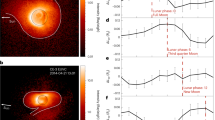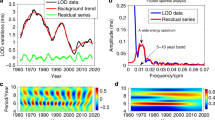Abstract
IT has recently been found1'2 that semi-diurnal lunar variations are derivable from the routine measurements made at ionospheric observatories. These variations are found not only in the heights of all the principal ionospheric regions, but also1 in the maximum electron densities of the F2 region. Near the magnetic equator they are found to be very large indeed, the height variations being at certain times some fifty times greater than the already large variations previously found by Appleton and Weekes3 in the E region.
This is a preview of subscription content, access via your institution
Access options
Subscribe to this journal
Receive 51 print issues and online access
$199.00 per year
only $3.90 per issue
Buy this article
- Purchase on Springer Link
- Instant access to full article PDF
Prices may be subject to local taxes which are calculated during checkout
Similar content being viewed by others
References
Martyn, D. F., Proc. Roy. Soc., A, 190, 273 (1947).
Martyn, D. F., Proc. Roy. Soc., A, 194, 429 (1948).
Appleton, E. V., and Weekes, K., Proc. Roy. Soc., A, 171, 171 (1939)
Pekeris, C. L., Proc. Roy. Soc., A, 158, 650 (1937).
Martyn, D. F., Proc. Roy. Soc., A, 189, 241 (1947).
Schuster, A., Phil. Trans. Roy. Soc., A, 208, 163 (1908).
Martyn, D. F., Nature, 160, 535 (1947).
Author information
Authors and Affiliations
Rights and permissions
About this article
Cite this article
MARTYN, D. Lunar Variations in the Principal Ionospheric Regions. Nature 163, 34–36 (1949). https://doi.org/10.1038/163034a0
Issue Date:
DOI: https://doi.org/10.1038/163034a0
This article is cited by
-
Seasonal variation of the lunar tidal effects in the F2 layer of the ionosphere over Indian stations
Proceedings of the Indian Academy of Sciences - Section A (1963)
-
Variation with lunar phase of midday critical frequencies and heights of the F2 layer over Ahmedabad and other low latitude stations
Proceedings of the Indian Academy of Sciences - Section A (1956)
Comments
By submitting a comment you agree to abide by our Terms and Community Guidelines. If you find something abusive or that does not comply with our terms or guidelines please flag it as inappropriate.



